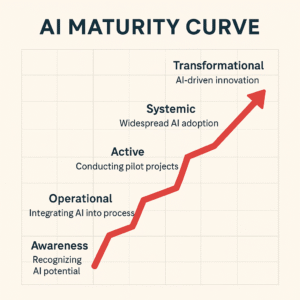
Understanding the AI Maturity Curve
The AI Maturity Curve is a strategic framework that outlines the stages businesses undergo as they adopt and integrate artificial intelligence (AI) into their operations. It serves as a roadmap, helping organizations identify their current position and plan for progression. By understanding where they stand, businesses can develop targeted strategies to harness AI’s full potential.
The Five Stages of AI Maturity
The AI Maturity Curve comprises five distinct stages, each representing a level of AI integration and sophistication within an organization.
1. Awareness
At this initial stage, businesses recognize AI’s potential but have not yet implemented any AI initiatives. Discussions about AI may occur, but there is a lack of concrete plans or pilot projects.https://www.usaii.org/
2. Active
Companies begin experimenting with AI through pilot projects and small-scale implementations. This phase involves testing AI applications in controlled environments to assess feasibility and value.https://www.usaii.org/
3. Operational
AI technologies are integrated into core business processes, enhancing efficiency and decision-making. Organizations at this stage have moved beyond experimentation, deploying AI solutions that deliver tangible benefits.
4. Systemic
AI becomes a fundamental part of the organization’s operations, with widespread adoption across departments. AI initiatives are aligned with business strategies, and data-driven decision-making is prevalent.
5. Transformational
At this pinnacle stage, AI drives innovation and creates new business models, offering a significant competitive advantage. Organizations leverage AI to disrupt markets, redefine customer experiences, and achieve exponential growth.
Assessing Your Business’s AI Maturity
To determine your organization’s position on the AI Maturity Curve, consider the following factors:
AI Integration
Evaluate how deeply AI is embedded in your business processes. Are AI solutions isolated to specific departments, or are they integrated across the organization?
Data Management
Assess the quality and accessibility of your data for AI applications. High-quality, well-governed data is essential for effective AI deployment.
Talent and Skills
Consider the expertise of your workforce in AI technologies. Do you have skilled professionals who can develop, manage, and interpret AI solutions?
Leadership and Strategy
Examine the commitment of leadership to AI initiatives and the presence of a clear AI strategy. Strong leadership support and strategic alignment are critical for AI success.
Advancing Along the AI Maturity Curve
To progress to higher stages of AI maturity, businesses should:
Invest in Training
Enhance the AI skills of employees through targeted training programs. Building internal capabilities ensures sustainable AI adoption.
Develop a Clear Strategy
Formulate a comprehensive AI strategy aligned with business goals. This strategy should outline objectives, resource allocation, and success metrics.
Foster a Data-Driven Culture
Encourage data-centric decision-making across the organization. Promote the use of data analytics and AI insights to inform strategies and operations.
Implement Scalable AI Solutions
Adopt AI technologies that can grow with your business needs. Scalable solutions ensure that AI initiatives remain effective as the organization evolves.
Conclusion
Understanding and navigating the AI Maturity Curve is crucial for businesses aiming to leverage AI effectively. By assessing your current stage and implementing strategic initiatives, your organization can harness the full potential of AI to drive innovation and growth.
Are you looking to embark upon an ethical and proper implementation of AI? You can do so with the help of experts like our company who does this daily with several leading firms. Please click here if you would like to reach out for a consultation.
